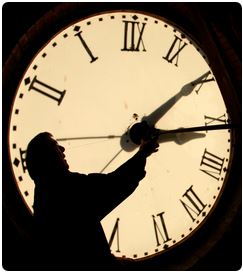
The Science Behind Daylight Savings
From The Vista Voice
By Laurie Fry
Those of us who have fond summer-night memories of chasing fireflies and starry-night sleepovers might have an emotional attachment to Daylight Savings Time. But is there any scientific basis for the implied savings? Does moving the clock forward actually save anything?
The clock shift was first suggested by Benjamin Franklin, the out-of-the-box thinker who seemed to appreciate the virtues of the early bird. An article in LiveScience suggests that Franklin believed that many people slept through morning light, which meant they stayed up later in the dark hours, using more candles than might have been necessary.
According to National Geographic, the practice wasn’t actually instituted until World War I, when Germany first implemented it as a way to save coal during the war. Other countries followed suit, including the United States, which made the practice mandatory during World War II’s stringent resource rationing for the war effort.
But does saving time actually save energy?
The evidence is mixed, according to research cited by Scientific American. A study done during the 1970s energy crisis showed that Daylight Savings Time cut energy usage by 1 percent. But a later study done in Indiana showed the opposite: a 1 percent rise in energy use.
An article in Tufts Now cites Michael Downing, author of “Spring Forward: The Annual Madness of Daylight Saving Time,” who claims that the annual clock-resetting is about retail sales, not energy savings. According to the article, the charcoal and barbecue grill industries, among others, lobbied to extend daylight savings because sales spike during the longer summer evenings.
But the clock shift does affect human energy. A blog post on Business Insider cites several ways the time change affects sleep patterns and daytime sleepiness, leading to lost productivity, accidents and even heart attacks.
Teens may be particularly affected by time shifts because their circadian rhythms are already out-of-synch with early high school schedules. A Washington Post article covers how sleep deprivation causes problems with learning, sports and health, particularly in young people whose bodies naturally want to stay up late and sleep in later. A twice-a-year time shift just exacerbates the problem of trying to set a sleeping pattern that fits the over-busy teen schedule.
On the other hand, an article in Science News cites studies that show the extended hours of evening light led to a slight increase in physical activity of children. In the increasingly sedentary lives of young people, any uptick in exercise could be considered a good thing.
So the scientific opinion is still divided. Until the issue is conclusively decided, maybe it’s best to just enjoy the longer days – and the memories of those languidly warm summer evenings.
To view embedded links visit the original post at http://vista.gmu.edu/news-and-research/blog/2015/03/05/daylight-savings-time/